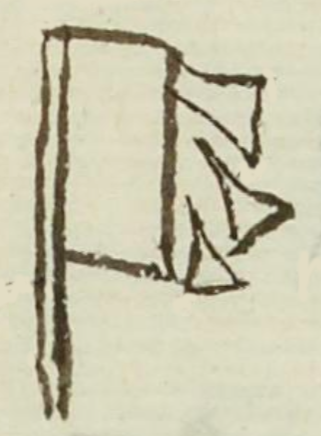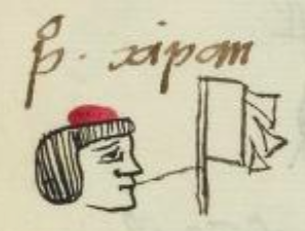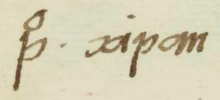Xipan (MH875v)
This black-line drawing of the simplex glyph for the personal name Xipan (perhaps “Turquoise Blue Flag”), which is attested here as a man’s name. The glyph shows a white, upright flag (panitl or pamitl) on a stick and, to the right of that, some turquoise tesserae (xiuh-). Both elements may be phonetic indicators (xi- and -pan) that combine for the name Xipan (seemingly the same name as the famous Xipantecuhtli, a lord from Tlaxcala who went out to meet Cortés on his march inland in 1519). As Juan José Batalla Rosado notes (2021, 477), this is a rare occurrence where turquoise is used as the simple phonetic syllable, xi-. It remains to be determined just what the name Xipan actually means.
Stephanie Wood
Batalla Rosado has raised the question of Xipan really intending Xipal (from xippalli, the turquoise blue color). Perhaps the original, now famous Xipan, from Tlaxcala, had a turquoise-blue flag insignia, and if that were the case, then the name would be fully logographic rather than perhaps partly phonetic. Further research remains to clarify this decipherment.
Stephanie Wood
po. xipan
Pedro Xipan
Stephanie Wood
1560
Jeff Haskett-Wood
banderas, teselas, turquesas, nombres de hombres

Xipantecuhtli, the name or title of a man from Tlaxcala who went out to meet Cortés in 1519, https://nahuatl.wired-humanities.org/content/xipantecuhtli
xihu(itl), turquoise, https://nahuatl.wired-humanities.org/content/xihuitl-0
xippal(li), the color turquoise blue, https://nahuatl.wired-humanities.org/content/xippalli
pan(itl) or pam(itl), flag, https://nahuatl.wired-humanities.org/content/panitl
posiblemente, Bandera del Color Turquesa
Stephanie Wood
Matrícula de Huexotzinco, folio 875v, World Digital Library, https://www.loc.gov/resource/gdcwdl.wdl_15282/?sp=823&st=image.
This manuscript is hosted by the Library of Congress and the World Digital Library; used here with the Creative Commons, “Attribution-NonCommercial-ShareAlike 3.0 License” (CC-BY-NC-SAq 3.0).










